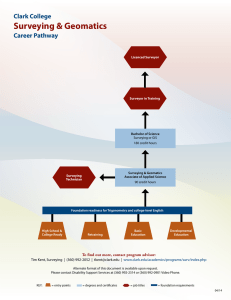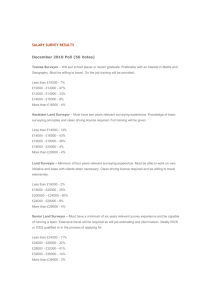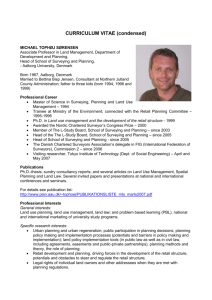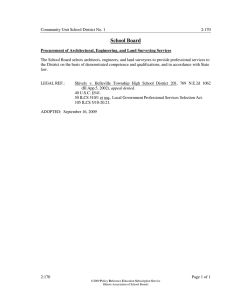155 Seminar on The Overview of ... MS Garden Kuantan Pahang.
advertisement
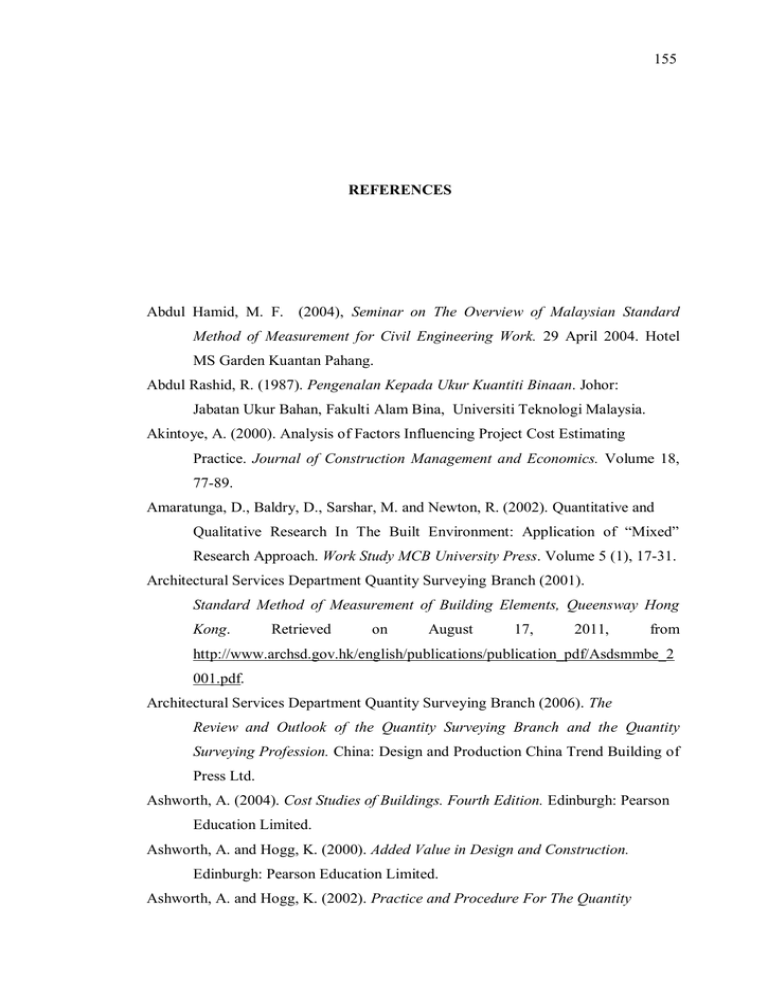
155 REFERENCES Abdul Hamid, M. F. (2004), Seminar on The Overview of Malaysian Standard Method of Measurement for Civil Engineering Work. 29 April 2004. Hotel MS Garden Kuantan Pahang. Abdul Rashid, R. (1987). Pengenalan Kepada Ukur Kuantiti Binaan. Johor: Jabatan Ukur Bahan, Fakulti Alam Bina, Universiti Teknologi Malaysia. Akintoye, A. (2000). Analysis of Factors Influencing Project Cost Estimating Practice. Journal of Construction Management and Economics. Volume 18, 77-89. Amaratunga, D., Baldry, D., Sarshar, M. and Newton, R. (2002). Quantitative and Qualitative Research In The Built Environment: Application of “Mixed” Research Approach. Work Study MCB University Press. Volume 5 (1), 17-31. Architectural Services Department Quantity Surveying Branch (2001). Standard Method of Measurement of Building Elements, Queensway Hong Kong. Retrieved on August 17, 2011, from http://www.archsd.gov.hk/english/publications/publication_pdf/Asdsmmbe_2 001.pdf. Architectural Services Department Quantity Surveying Branch (2006). The Review and Outlook of the Quantity Surveying Branch and the Quantity Surveying Profession. China: Design and Production China Trend Building of Press Ltd. Ashworth, A. (2004). Cost Studies of Buildings. Fourth Edition. Edinburgh: Pearson Education Limited. Ashworth, A. and Hogg, K. (2000). Added Value in Design and Construction. Edinburgh: Pearson Education Limited. Ashworth, A. and Hogg, K. (2002). Practice and Procedure For The Quantity 156 Surveyors. Oxford: Blackwell Science Ltd. Babalola, O. (2009). An Appraisal of the Factors Affecting Production of Cost Estimates for Electrical Services in Nigeria. Journal of Environmental Design and Management. Volume 2 (1), 56-63. Bankel et al. (2003). The CDIO syllabus: A Comparative Study of Expected Student Profiency. European Journal of Engineering Education. Volume 28 (3), 297-315. Bechina, A. A. A., Ribiere, V., Worashinchai, L. (2009). The Role of Knowledge Flow in The Thai GUIN Version of Triple Helix Model. Electronic Journal of Knowledge Management. Volume 7(2), 287-296. Bergthold, R. (1998). Building Services Integration. London: E. & F. N. Spoon Ltd 1983. Bessant, J. and Rush, H. (1995). Building Bridges For Innovation: The Role of Consultants In Technology Transfer. Volume 24 (1), 97-114. Best, R. (2005). How Much Measurement is Enough? Quantity Surveying Education in Australia. The Journal of The Australia Institute of QS. The Building Economist. 16-20. Bitner, M. J (1995). Building Service Relationship: It’s All About Promises. Journal of the Academy of Marketing Science. Volume 23 (4), 246-251. Black, C. Akintoye, A. Fitzgerald, E. (2000). An Analysis of Success Factors and Benefits of Partnering in Construction. International Journal Project Management. Volume 18 (6), 423-434. Board of Quantity Surveyors, BQSM (2009). Quantity Surveyor. Retrieved on October 25, 2011, from www.bqsm.gov.my. Bownass, D. (2000). Building Services Design Methodology. London and New York.: Spon Press Taylor & Francis Group. Brewer, J. and Hunter, A. (1989). Multimethod Research: A Synthesis of Styles. Newbury Park. CA: Sage Publications. Cartlidge, D. (2009). Quantity Surveyor’s Pocket Book. United Kingdon: Routledge. College of Estate Management (2010). Cost Control and Cost Management of M&E Services. The College of Estate Management 2010. Paper 8167V1-0, 1-16. College of Estate Management (2012). Prospectus 2012/13 Building Futures. BSc (Hons) in Building Services Quantity Surveying. Retrieved on November 14, 2011, from www.cem.uk/bsqs. 157 Cohen, J. (1992). Quantitative Methods in Psychology: A Power Primer. Psychological Bulletin. Volume 112 (1), 155-159. Chua, L. C. (2006). Sample Size Estimation Using Krejcie and Morgan and Cohen Statistical Power Analysis: A Comparison. Jurnal Penyelidikan IPBL. Jilid 7. Cheng, J. C. P., Law, K. H., Bjornsson, H., Jones, A., Sriram, R. (2010). A Service Oriented Framework for Construction Supply Chain Integration. Automation in Construction. Volume 19, 245-260. Cheung, F. K. T. and Skitmore, M. (2006). Application of Cross Valiation Techniques for Modelling Construction Costs During The Very Early Design Stage. Building and Environment. Volume 41 (12), 1973-1990. Churcher, D. (2009). A Design Framework For Building Services 2nd Edition. A BSRIA Guide. Berkshire: ImageData Ltd. Collier, K. (1986). Estimating Construction Costs, Virginia: Reston Publishing Company, Incorporate, A Prentice-Hall Company Reston. Coman, A. and Ronen, B. (2009). Focused SWOT: Diagnosing Critical Strengths and Weaknesses. International Journal of Production Research. Volume 47 (20), 5677-5689. Cooke. B and Walker G. (1994). European Construction: Procedures and Techniques. Houndmills, Basingstoke, Hampshire RG21 2XS and London: The Macmillan Press Ltd. Creswell, J. W. (2003). Research Design: Qualitative, Quantitative and Mixed Methods Approaches (2nd Edition). Thousand Oaks, CA: Sage Publication. Creswell, J.W. and Plano Clark, V. L. (2007). Designing and Conducting Mixed Methods Research. Thousand Oaks, London and New Delhi: Sage Publications. Creswell, J. W. and Miller, D. L. (2000). Determining Validity in Qualitative Inquiry. Theory Into Practice. Volume 39(3), 124-131. Cronbach, L. and Meehl, P. (1995). Construct Validity in Psychological Tests. Psychological Bulletin. 281-302. Crotty, M. (1998). The Foundations of Social Research: Meaning and Perspective in the Research Process. London: Sage Publication. Davenport, T. H., Long, D. W. D. and Beers, M. C. (1998). Successful Knowledge Management Projects. Sloan Management Review Winter 1998. 158 Davis Langdon (2010). Africa Region Property and Construction Handbook. Africa: AECOM. Davis, R., Watson, P. and Chi, L. M. (2007). Knowledge Management For The Quantity Surveying Profession. Strategic Integration of Surveying Services FIG Working Week 2007. Hong Kong SAR, China 13-17 May 2007. Dent, C. (1980). Construction Measurement In Accordance With SMM6, London: Granada Publishing Limited. Department of Education and Science Planning and Building Unit (2004). Mechanical and Electrical Building Services Engineering Guidelines for Primary School Buildings. First Edition February 2004, Tullamore: Co. Offaly. Dow, I., Sertyesilisik, B. and Ross, A. D. (2005). An Investigation on The Implications of Methodology of Sub-Contract Work Pricing. Journal of Financial Management of Property and Construction. Volume 14 (2), 98-125. Ekundayo, D. (2011). Mapping of Sustainability Education to Construction Related Curricula: A Case Study of Quantity Surveying (QS) Degree Programme. RICS COBRA Conference 2011. 12-13 September 2011, School of Built Environment, University of Salford. Flick, U. (2004). Triangulation: Qualitative Social Research. Springer D.E. Fotwe, F. T. and McCaffer, R. (2000). Developing Project Management Competency: Perspective From The Construction Industry. International Journal of Project Management. Volume 18, 111-124. Fussell, W. F. J. (1971). The Measurement of Engineering Services. London: E. & F. N. SPON LTD. Gibbs, G. (2007). Analizing Qualitative Data. London: Sage Publication Ltd. Gliem, J. A. and Gliem, R. R. (2003). Calculating, Interpreting and Reporting Cronbach’s Alpha Reliability Coefficient for Likert Scales. Midwest Research to Practice Conference in Adult, Continuing and Community Education. Gonick, L. and Smith, W. (1993). The Cartoon Guide to Statistics. HarperPerennial. A Division of HarperCollinsPublishers. Gura, J. H (1984). Role of the Building Services Engineering Consultant. IEEE Proceeding. Volume 131 (6), 413-419. Hague, P. (1993). Questionnaire Design. 120 Pentonville Road London N1 9JN: Kogan Page Limited. 159 Hassan, F., Ismail, Z. Zaini, A. A., Hassan, S. and Maisham, M. (2011). An Evaluation of The Competencies, Skills and Knowledge of Quantity Surveying Graduates in Consultant Quantity Surveying Firms in Malaysia. Humanities. Science and Engineering (SHUSER) 2011 IEEE Colloqium. 5-6 December 2011 Penang, 228-232. Headrick, H. (2008). Techniques to Improve Your Partnership: Undertaking a SWOT Analysis. Retrieved on February 25, 2013, from http://www.espartsed.org/resources/ss08_headrick_SWOT_Analysis_Model.d oc. Hendrickson, C. (1998). Project Management for Construction: Fundamental Concepts for Owners, Engineers, Architects and Builders. Department of Civil and Environmental Engineering, Carnegie Mellon University, Pittsburgh, PA 15213: Prentice Hall. Hiew, H. and Ng, P. (2007). How The QS Can Create Values in The Procurement of Construction Works in Hong Kong. Strategic Integration of Surveying Services FIG Working Week 2007. Hong Kong SAR, Chine 13017 May 2007. Hignett, S. (2005). Qualitative Methodology. Taylor & Francis Group, LLC. Hoinville, G., Jowell, R. and Hoffman, K. R (1978). Survey Research Practice. London: Heinemann Education Books. Huntsberger, David V. and Billingsley, Patrick P. (1989). Elements of Statistical Inference, Dubuque, Iowa: Wm. C. Brown Publishers. Hussin, A. A and Omran, A. N.(2009). Roles of Professional in Construction Industry. The International Conference on Economics and Administration, Faculty of Administration and Business, University of Bucharest, Romania. ICEA – FAA Bucharest, 14 – 15th November 2009. Hwang, B. G. and Ng, W. J. (2012). Project Management Knowledge and Skills for Green Construction: Overcoming Challenges. International Journal of Project Management. Volume 31(2), 272-284. Jackson, R. M. and Powell, J. L. (1992). Jackson and Powell on Profession Negligence, 3rd Ed. London: Sweet & Maxwell Ltd. Johnson, B. (2001). Toward a New Classification of Nonexperimental Quantitative Research. London: Sage Publication and American Education Research Association. 160 Kanapeckiene, L., Kaklauskas, A., Zavadskas, E. K. and Seniut, M. (2010). Integrated Knowledge Management Model and System for Construction Projects. Engineering Application of Artificial Intelligence. Volume 23, 12001215. Korman, T. M. (2008). Using Building Information Modeling To Improve The Mechanical, Electrical and Plumbing Coordination Process for Building. ACSE Conference Proceeding. AEI 2008: Building Integration Solution. Kotler, P. (2010). Principles of Marketing. London: Prentice-Hall. Krejcie, R. B. and Morgan, D. W. (1970). Determining Sample Size for Research Activities. Journal of Educational and Psychological Measurement. 607-610. Lam, A. (2000). Tacit Knowledge, Organizational Learning and Societal Intitutions: An integrated Framework. European Group for Organizational Studies. Volume 21, 487-513. Lee, S., Trench, W. and Willis, A (2005), Willis’s Elements of Quantity Surveying. 9600 Garsington Road, Oxford OX4 2DQ, UK: The Blackwell Publishing Ltd. Levitt, R. E. (1994). Building Construction Estimating. New York: McGraw-Hill Series in Construction Engineering and Project Management. Liebowitz and Beckman (1998). Knowledge Organizations: What Every Manager Should Know. St. Lucie: CRC Press Publication. Liebowitz, J. (2005). Linking Social Network Analysis With The Analytic Hierarchy Process For Knowledge Mapping In Organizations. Journal of Knowledge Management. Volume 9 (1), 76-86. Love, P. E. D. (2002). Influence of Project Type and Procurement Method on Rework Costs in Building Construction Projects. Journal of Construction Engineering and Management. Volume 128, 18-29. Love, P. E. D., Skitmore, M. and Earl, G. (1998). Selecting A Suitable Procurement Method For A Building Project. Journal of Construction Management and Economics. Volume 16 (2), 221-223. Mahbub, R. (2001). Perception and Expectation of Employers on the Quality of Quantity Surveying Graduates Entering the Construction Industry. Quantity Surveyor National Conference. 8-9 May 2001, 1-9. Maidin, A. J. and Sulaiman, S. S. (2011). Importance of Legal Education For 161 Quantity Surveying Professionals: A Proposal For Developing A Legal Studies Module For Malaysian System. Journal of Applied Sciences Research. Volume 7 (13), 2249-2256. Mainali, B., Ngo, H. H., Guo, W., Pham, T. T. N. and Johnston, A. (2011). Feasibility Assessment of Recycled Water Use for Washing Machines in Australia Through SWOT Analysis. Resources, Conservation and Recycling. Volume 56, 87-91. Marsh, C. (2003). Building Services Procurement. London and New York: Spon Press Taylor & Francis Group. Matipa, W. M., Kelliher D., Keane M. (2008). How A Quantity Surveyor Can Ease Cost Management at The Design Stage Using A Building Product Model. Construction Innovation. Volume 8 (3), 164-181. McCaffrey, J (2010). What is an M&E QS? Retrieved on August 8, 2011, from http://www.isurv.com. McKenzie, G., Powell, J. and Usher, R. (1997). Understanding Social Research: Perspectives on Methodology and Practice. London and Washington, DC.: The Falmer Press (A Member of the Taylor & Francis Group). Mercy, M. O. (1997). An Overview of Quantity Surveyors as Project Managers in Nigeria: Unpublished B. Tech. Dissertation. Department of Quantity Surveying, Federal University of Technology. Merriam, S. B. (1998). Qualitative Research and Case Study Applications in Education. San Francisco: Jossey-Bass. Meyer, T. and Semark, P. (1996). A Framework for The Use of Competencies for Achieving Competitive Advantage, South African Journal of Business Management. Volume 27 (4), 96-103. Michie, A. (1981). Integration and Coordination of Building Services and Its Relation With Project Management. Building Services Engineering Research and Technology. Volume 2, 15-26. Moeckli, J. (2011). Handbook of Driving Simulation for Engineering, Medicine and Psychology: The Qualitative Interview. The University of Iowa: Taylor & Francis Group, LLC. Mohamed, S. F. (2010). Research Methodology Workshop: Latest Research Tools and Techniques. CRIOCM 2010 15th International Symposium on 162 Adavanvcement of Construction Management and Real Estate Towards Sustainable Development of International Metropolis, 6th August 2010. Mohamed, S. F. and Anumba, C. J. (2004). Towards A Framework For Integrating Knowledge Management Processes Into Site Management Practices. 20th Annual ACROM Conference. 1-3 September 2004, Heriot Watt University. Association of Researchers in Construction Management. Volume 1, 45-54. Mohamed, S. F., Yusoff, M. Z., Misnan, M. S., Mahmud, S. H., Remeli, S. (2012). Towards A Framework to Integrate Quantity Surveyors’ Knowledge in Building Services Works. 3rd International Conference On Construction Industry (ICCI) 2012. Padang, Indonesia, 2-4 April 2012. Mohamed, S. F. and Yusuf, G. A. (2011). Examination of Pre-Tender Budgeting Techniques for Mechanical and Electrical Services in Malaysia. WASET: World Academy of Science and Technology Conference Kuala Lumpur Malaysia. 28-29 August 2012, Kuala Lumpur. Moser, C., and Kalton, G. (1993). Survey Methods in Social Investigation. Aldershot: Gower. Murray, G. P. (1997). Measurement of Building Services. MacMillan Press Ltd. Naoum, S. G. (2007). Dissertation Research & Writing For Construction Students. Hungary: Elsevier Ltd. Neideen, T. and Brasel, K. (2007). Understanding Statistical Tests. Journal of Surgical Education by The Association of Program Directors in Surgery Published by Elsevier. Volume 64 (2), 93-96. Newman, L. (2005). Handbook of Human Factors and Ergonomics Methods. Pennsylvania State: CRC Press LLC. Nkado, R. (2001). Competencies of Professionals Qss: A South African Perspective. Construction Management and Economics. Volume 19, 481-491. Nonaka, I. and Takeuchi, H. (1995). The Knowledge Creating Company, How Japanese Companies Create The Dynamics of Innovation. Oxford: Oxford University Press. Nonaka, I. and Takeuchi, H. (1995). Theory of Organizational Knowledge Creation. Oxford: Oxford University Press. Oberlender, D. G. (1993). Project Management for Engineering and Construction, International Editions. Singapore: McGrawhill Book Co. 163 Odeyinka, H. A. (2003). The Development and Validation of Models for Assessing Risk Impacts on Construction Cash Flow Forecast. Glasgow Caledonian University. Odusami, K. T. (2002). Perceptions of Construction Professionals Concerning Important Skills of Effective Project Leaders. Journal of Management in Engineering. Volume 18(2), 61-67. Odusami, K. T and Iyagba, R. R (2001). The Most Suitable Professional for Team Leadership on Building Projects as perceived by The Proefessionals in The Construction Industry. The Professional Builder, July Edition, 64-73. Ofori, G. and Lean, C. S. (2001). Factors Influencing Development of Construction Enterprises in Singapore. Journal of Construction Management and Economics. Volume 19 (2), 145-154. Ogunsemi, D. R., Oyediran, O. S. and Ekundayo, D. O. (2012). Construction Professionals and Project Management Competencies in Nigeria. Journal of Construction. Official Journal of The Association of School of Construction of South Africa. Volume 1 and Volume 2, 6-11. Oladipupo, B. R. (2004). Comparative Study of Construction Professionals as Project Managers in Nigeria. Department of Quantity Surveying, Federal University of Techology. Pallant, J. (2001). SPSS Survival Manual. John Wiley Publications. Parsloe, C. and Wild, J. (1992). Project Management Handbook for Building Services. Building Services Research and Information Association. Pathirage, C. and Amaratunga, D. (2006). A Vision For The Quantity Surveying Education in The 21st Century United Kingdom Perspective in Customising the Quantity Surveying Education, Department of Building Economics, University of Moratuwa, Sri Lanka. Pathirage, C., Haigh, R., Amaratunga, D. and Baldry, D. (2008). Knowledge Management Practices in Facilities Organizations: A Case Study. Journal of Facilities Management. Volume 6 (1), Oct, 5-22. Pavittland, T. C. and Gibb, A. G. F. (2003). Interface Management Within Construction: In Particular, Building Façade. Journal of Construction Engineering and Management. Volume 129, 8-15. Perera, S. and Pearson, J. (2011). Alignment of Professional, Academic and 164 Industrial Development Needs for Quantity Surveyors: The Post Recession Dynamics. RICS Trust Grant Project No: 401. Northumbria University Newcastle Upon Tyne United Kingdom. Potts, K. 92008). Construction Cost Management: Learning From Case Studies. London: Taylor and Francis. Powell, C. and Mole, T. (2003). The Surveyors’ Construction Handbook. RICS Business Limited. The Royal Institution of Chartered Surveyors UK. Project Management Institute (2000). A Guide to The Project Management Body of Knowledge. 2000 Edition. Newtown Square, Pennsylvinia: Nutek Incorporate. Ramaprasad, A. and Prakash, A. N. (2003). Emergent Project Management: How Foreign Managers Can Leverage Local Knowledge. International Journal Project Management. Volume 21, 199-205. Ramus, J. and Birchall, S. (1994). Contract Practice for Surveyors. Reed Educational and Professional Publisher Ltd. Rawlison, S., Nugent, B., Dedman, A. (2007). Procurement: Building Services. Retrieved on January 14, 2014, from www.building.co.uk/procurementbuilding-services/3086544.article. Rawlison, S. and Dedman, A. (2010). Specialist Costs: M&E Services. Retrieved on January 14, 2014, from www.building.co.uk/specialist-cost-me- services/5001903.article. Reed, J. (2009). RSMeans Building Constrcution Cost Data. Reed Construction Data. Remeli, S. (2011). Aplikasi SMM 2 Dalam Kerja-Kerja Perkhidmatan Bangunan. Sarjana Muda Ukur Bahan. Universiti Teknologi Malaysia. Remeli, S. and Mohamed, S. F. (2012). Towards a Framework To Integrate The Usage of Standard Method of Measurement in Building Services Works. APSEC-ICCER; Sustaining The World with Better Structures & Construction Practice 2012. Surabaya, Indonesia 2-4 October 2012. Rezgui, Y., Hopfe, C. J. and Vorakulpipat, C. (2009). Generations of knowledge management in Architecture, Engineering and Construction Industry: An Evolutionary Perspective. Advanced Engineering Informatic. Volume 24, 219-228. Ribeiro, F. L. and Ferreira, V. L. T. (2010). Using Knowledge to Improve Preparation of Construction Projects. Business Process Management Journal. Volume 16 (3), 361-376. 165 Richrath, B. (2007). Design and Project Management. Real Estate Investments in Germany, 123-147. Ritchie, J. and Lewis, J. (2003). Qualitative research Practice: A Guide for Social Science Students and Researchers. London and New Delhi: Sage Publications Thousand Oaks. Robinson, N. M. (1978). Measurement (Volume 1). 32 Malmesbury Road, Kingsditch, Cheltenham: Stanley Thornes (Publishers) Ltd. Robson, C. (2002). Real World Research. Blackwell, 2nd Ed. Rosenholtz, R. (2009). A Very Brief Intro to Statistics: T-tests. Laboratory in Visual Cognition Fall 2009. Royal Institution of Chartered Surveyors (1991). Constructing Real Estate Indices for Cyprus: An Evaluation of The Options, Reading United Kingdom. Royal Institution of Chartered Surveyors (1998). The ABC Requirements and Competencies. London. Royal Institution of Chartered Surveyor (2012). RICS New Rules of Measurement: Detailed Measurement for Building Works. RICS, Page Bros, Norwich. Ruan, X., Ochieng, E. G., Price, A. D. F and Egbu, C. O. (2012). Knowledge Integration Process in Constrcution Projects: A Social Network Analysis Approach to Compare Competitive and Collaborative Working. Construction Management and Economics. Volume 30 (1), 5-19. Said, I., Shafiei, M. W. M, Omran, A. (2009). The Competency Requirements For Quantity Surveyors: Enhancing Continuous Professional Development. ACTA Technica Corviniensis: Buletin of Engineering. Sambasivan, M and Soon, Y (2007). Causes and Effects of Delays in Malaysian Construction Industry. International Journal of Project Management. Volume 25, 517-526. Samekto, H (2007). Integrated Approach in Materials and Engineering Design. Regional Symposium on Engineering Education 2007, 14 February 2007, Universiti Malaya. Sanchez, A. (1998). Telephone Interview with Alfred Sanchez, President, Alfred J. Sanchez Inc., February 1998. Sandhu, M. S., Jain, K. K. and Ahmad, U. K. (2010). Knowledge Sharing Among 166 Public Sector Employees: Evidence From Malaysia. International Journal of Public Sector Management. Volume 24 (3), 206-226. Sattar, S. (2012). Exploring Knowledge Management Practices. International Journal of Learning & Development. Volume 2 (1), 330-352. Seeley, I. H. (1965). Building Quantities Explained S.I Edition. London and Basingstoke Associated Companies in New York, Melbourne, Toronto, Johannesburg and Madras: Macmillan and Co Ltd. Seeley, I. H. (1982). Advanced Building Measurement, Chartered Quantity Surveyor Professor and Head of Department of Surveying and Dean of the School of Environmental Studies, Trent Polytechnic, Notthingham. Seeley, I. H. (1989). Advanced Building Measurement- Building & Surveying. Basingtoke, Hampshire: Palgrave Macmillan. Seeley, I. H. (1993). Building Technology (Building & Surveying Series). Basingtoke, Hampshire: Palgrave Macmillan. Seeley, I. H. (1996). Building Economics (Building & Surveying Series). Basingtoke, Hampshire: Palgrave Macmillan. Seeley, I. H. (2006). Quantity Surveying Practice (2nd Edition). Basingtoke, Hampshire: Palgrave Macmillan. Senaratne, S. and Sabesan, S. (2008). Managing Knowledge As Quantity Surveyors: An Exploratory Case Study in Sri Lanka. Built-Environment- Sri Lanka. Volume 8 (2), 41-47. Senaratne, S. and Sexton, M. (2008). Managing Construction Project Change: A Knowledge Management Perspective. Journal of Construction Management and Economics. Volume 26 (12), 1303-1311. Shamsuddin, S. M., Zakaria, R., Moahmed, S. F. amd Mustaffar, M. (2012). Drivers and Challenges of Industrialised Building System (IBS) in Sustainable Construction. APSEC-ICCER; Sustaining The World with Better Structures & Construction Practice 2012. Surabaya Indonesia, 2-4 October 2012. Shehu, Z. and Akintoye, A. (2009). Major Challenges to the Successful Implementation and Practice of Programme Management in the Construction Environment: A Critical Analysis. International Journal of Project Management. Volume 28, 26-39. Smith, E. A. (2001). The Role of Tacit and Explicit Knowledge In The 167 Workplace. Journal Knowledge Management. Volume 5 (4). 311-321. Soliman, F. and Spooner, K. (2000). Strategies for Implementing Knowledge Management: Role of Human Resources Management. Journal of Knowledge Management. Volume 4 (4), 337-345. Statistical & Technical Team (1992). A Practical Guide to Sampling. National Audit Office. Sturft, C. S. and Griffis, F. H (2005). Pricing Engineering Services. Journal of Management in Engineering. Volume 21 (2), 56-62. Swaffield, L. and Pasquire, C. (2000). Improving Early Cost Advice Mechanical and Electrical services. Research Paper. Volume 3 (15). Department of Civil and Building Engineering Loughborough University. Syed Alwee, S. N. A., Hassan, P@F., Ramli, H., Maisham, M. (2011). Bloom’s Taxonomy in The Provision of Quantity Surveying Degree Programme. Business. Engineering and Industrial Applications (ISBEIA) 2011, IEEE Symposium. 25-28 September 2011, Langkawi Conference Publication, Page 431-436. Takim, R. and Adnan, H. (2008). Analysis of Effectiveness Measures of Construction Project Success in Malaysia. Asian Social Science (CCSE). Volume 4 (7), July 2008. Tasshakkori, A. and Teddlie, C. (1998). Mixed Methodology: Combining Qualitative and Quantitative Approaches. Thousand Oaks, CA: Sage Publication. Tasshakkori, A. and Teddlie, C. (2003). Handbook of Mixed Methods in Social & Behavioral Research. Sage Publication. The Institution of Surveyors, Malaysia (2001). Malaysian Standard Method of Measurement of Building Works Second Edition. Selangor: The Institution of Surveyors, Malaysia. Thompson, F. M. L. (1968). Chartered Surveyors : The Growth of A Profession, London: Routledge & Kegan Paul. Traister, J. E. (1975). Residential Electrical Design. inc Indianapolis, Kensas City, New York 1975: Howard W. Sams & Co. Inc. The Bobs-Merrill Co. Van Manen, M. (1990). Researching lived experience: Human Science for An Action Sensitive Pedagogy. London, ON: The University of Western Ontario. Willis, A. and Trench, W. (2002). Willis’s Elements of Quantity Surveying Ninth Edition. London: Blackwell Science Ltd. 168 Wright, P. H. (1994). Introduction to Engineering Second Edition. Keyword Publishing Services Ltd. Yeung et al. (2006). Attitudes Towards Industrial Training in The BEng. Course in Building Services Engineering at Hong Kong Polytechnic. Yik, F. W. H., Lai, J. H. K., Chan, K. T, Chau, C. K. and Lee, W. L. (2013). A Portrait of Building Services Engineers in Hong Kong. Engineering, Construction and Architectural Management. Volume 20 (1), 63-82. Yuan, H. (2013). A SWOT Analysis of Successful Construction Waste Management. Journal of Cleaner Production, Volume 39, 1-8. Yunus, R. and Yang, J. (2012). An Integrated Approach to Enhance Sustainability In Industrialised Building Systems. APSEC-ICCER; Sustaining The World with Better Structures & Construction Practice 2012. Surabaya, Indonesia, 2-4 October 2012. Yusuf, G. A. and Mohamed, S. F. (2011). Identification of The Potentials and Barriers of Adopting Standard Method of Measurement for Mechanical and Electrical Services in Malaysia. OIDA International Conference on Sustainable Development 2011. 5- 7 December 2011, Putrajaya Malaysia. Yusuf, G. A. and Mohamed, S. F. (2012). Perceived Benefits of Adopting StandardBased Pricing Mechanism for Building Services: Lesson from Building Fabrics and Finishes. Archives De Science. Volume 6 (9), September 2012. Yusuf, G. A., Mohamed, S. F., Mohd Yusof, Z. and Misnan, M. S. (2012). Framework for Enhancing Cost Management of Building Service. International Congress on Interdisciplinary Business and Social Science. Procedia-Social and Behavioral Sciences. Volume 65, 697-703. Zack, M. (1999). Developing A Knowledge Management Strategy. California Management Review, Spring. Volume 41 (3), 125-145. Zakaria, N., Che Munaaim, M. E. and Iqbal Khan, S. (2006). Malaysian Quantity Surveying Education Framework. Retrieved on June 14, 2012, from http://www.cebe.heacademy.ac.uk.news/events/beecon2006/pdf/P32_Norhani m_Zakaria.pdf. Zikmund, W. G. (1997). Business Research Method Fifth Edition. Fort Worth, Texas: The Dryden Press. Zhikun, D., Fungfai, N. and Qiying, Cai (2007). Personal Construct Affecting 169 Interpersonal Trust and Willingness to Share Knowledge Between Architects in Project Design Teams. Journal of Management and Economics. Volume 25 (9), 937-950.
